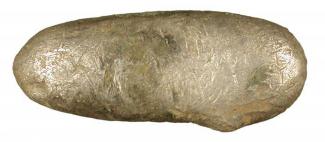Silver ingot
Viking or Anglo-Saxon, 9th-11th century AD
Found by a metal detectorist at Headbourne Worthy, Hampshire in 2003
This small ingot of metal has a silver content of 89 per cent. The upper surface is smooth, but the underside is pitted from casting in an open mould, which would have been simply made in sand or earth. Similar examples occur in Viking hoards of silver. Such ingots could have been used as bullion in payments or trade transactions, as well as a source of metal for jewellery making. It has been suggested that a Viking unit of silver weighed about 26 grams, so this ingot would therefore approximate to a Viking half unit. The presence of the ingot near to Winchester tempts us to speculate - does it imply the presence of Vikings in the area, or did it just belong to an Anglo-Saxon silversmith who carelessly lost it along the way?



